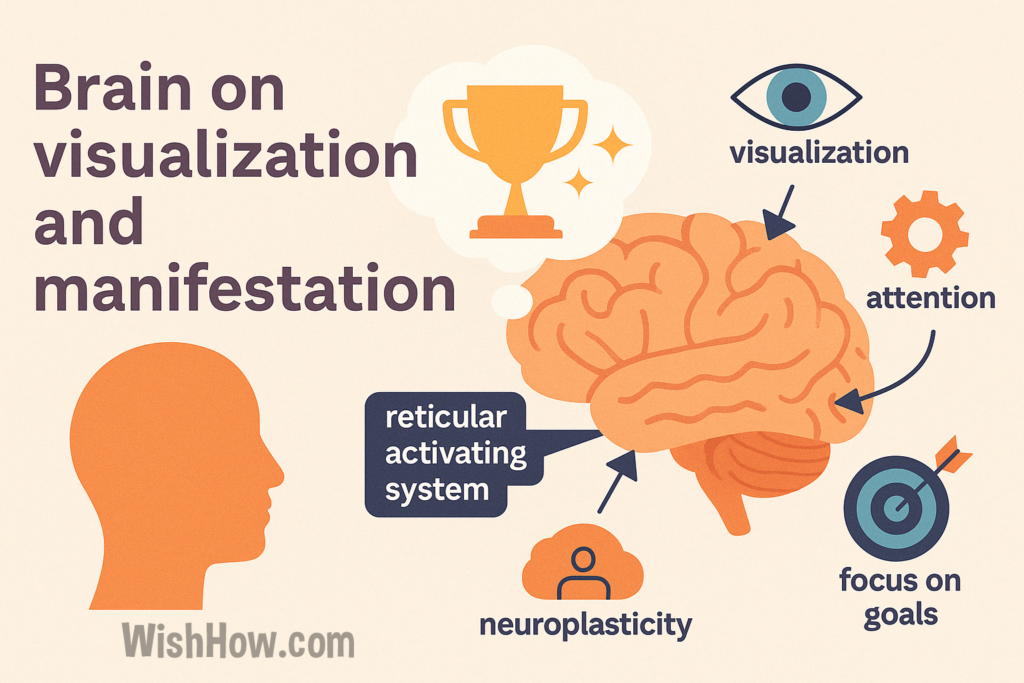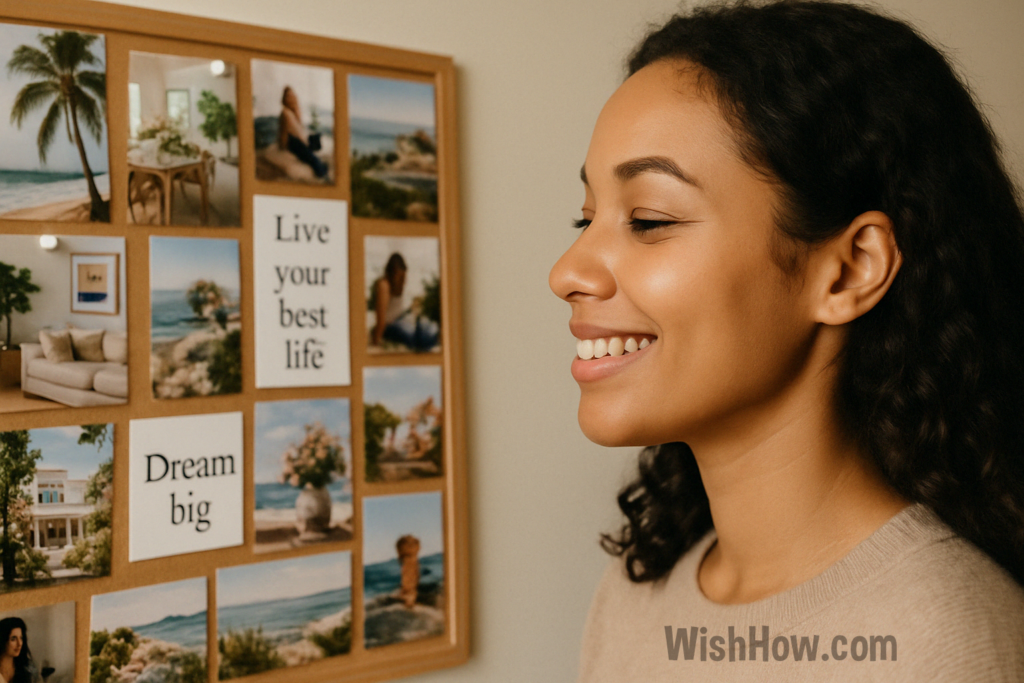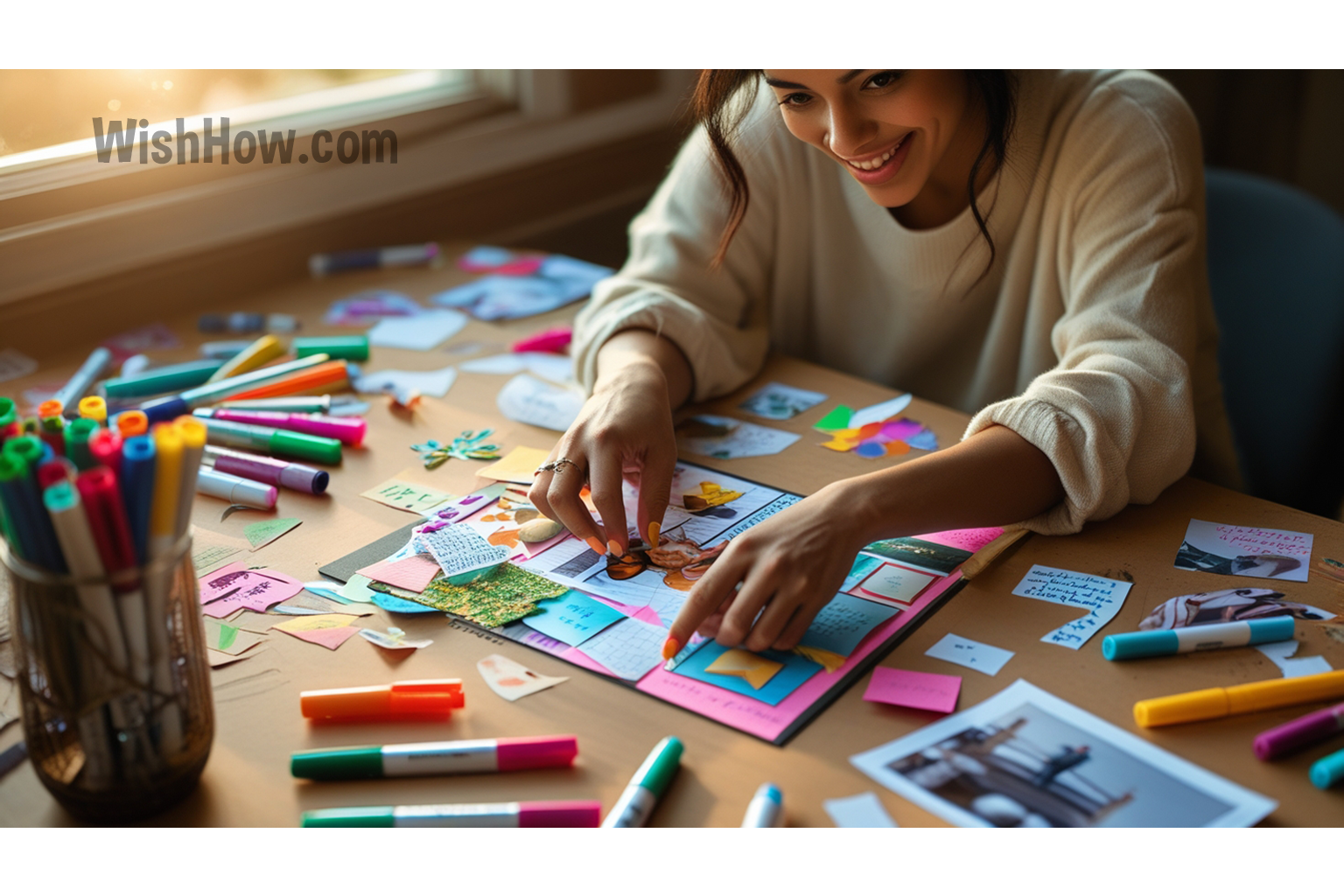Creating a vision board for manifestation is a powerful way to bring your dreams and goals into reality. By visually representing your aspirations, you can focus your energy and intentions on achieving them. Here’s a comprehensive guide to help you craft an effective vision board for manifestation.
What Is a Vision Board for Manifestation?
A vision board for manifestation is a collage of images, words, and affirmations that represent your aspirations and goals. It serves as a daily visual reminder of your intentions, keeping you focused and motivated. Whether it’s a physical board displayed in your home or a digital version on your devices, a vision board helps to clarify your desires and reinforces your commitment to achieving them.

Also Read: What Are the Best Manifestation Techniques?
The Science Behind Vision Boards for Manifestation
While vision boards are often associated with creative expression and goal setting, there’s substantial scientific evidence supporting their effectiveness in aiding manifestation. Understanding the neuroscience behind vision boards can enhance their impact and provide deeper insight into how they facilitate goal achievement.
1. Activation of the Reticular Activating System (RAS)
The Reticular Activating System is a network of neurons located in the brainstem that plays a crucial role in attention and awareness. By consistently exposing yourself to images and affirmations on your vision board, you program your RAS to recognize and prioritize opportunities aligned with your goals. This means you’re more likely to notice resources, connections, and situations that can help you manifest your desires.
2. Engagement of Neuroplasticity
Neuroplasticity refers to the brain’s ability to reorganize itself by forming new neural connections throughout life. Regularly visualizing your goals through a vision board strengthens the neural pathways associated with those goals. This reinforcement makes it easier for your brain to focus on and work towards your aspirations, effectively rewiring your mind for success.
3. Stimulation of the Visual Cortex
The visual cortex is the part of the brain responsible for processing visual information. When you look at your vision board, the visual cortex is activated, which can lead to increased motivation and emotional engagement with your goals. This emotional connection can drive you to take actionable steps toward achieving what you’ve visualized.
4. Influence on the Limbic System
The limbic system, which includes structures like the amygdala and hippocampus, is involved in emotion, behavior, and long-term memory. By associating positive emotions with the images and affirmations on your vision board, you create a strong emotional imprint. This emotional resonance can enhance memory retention and increase your commitment to pursuing your goals.
5. Promotion of Goal-Oriented Behavior
Vision boards serve as constant visual reminders of your objectives, which can lead to increased goal-oriented behavior. By keeping your goals at the forefront of your mind, you’re more likely to take consistent actions that align with your desired outcomes. This continuous focus helps bridge the gap between intention and action, a critical component in the manifestation process.
By understanding and leveraging these scientific principles, you can enhance the effectiveness of your vision board for manifestation. It’s not just about creating a visually appealing collage; it’s about engaging your brain’s natural processes to support your journey toward achieving your dreams.
Anxiety Relief Coloring Book for Adults: Mindfulness Coloring to Soothe Anxiety
$5.17 (as of April 28, 2025 21:51 GMT -07:00 - More infoProduct prices and availability are accurate as of the date/time indicated and are subject to change. Any price and availability information displayed on [relevant Amazon Site(s), as applicable] at the time of purchase will apply to the purchase of this product.)Step-by-Step Guide to Creating Your Vision Board for Manifestation
1. Clarify Your Goals
Begin by reflecting on what you truly want to manifest in various areas of your life, such as career, relationships, health, and personal growth. Write down specific, measurable, and time-bound goals to gain clarity and direction.
2. Choose Your Medium
Decide whether you prefer a physical or digital vision board. Physical boards can be created using poster boards, magazines, and glue, while digital boards can be designed using tools like Canva or Pinterest. Digital boards offer the convenience of easy updates and accessibility across devices.
3. Gather Materials
Collect images, quotes, and affirmations that resonate with your goals. These can be sourced from magazines, newspapers, or online platforms. Ensure that each element evokes a positive emotional response and aligns with your intentions.
4. Assemble Your Vision Board
Arrange your collected materials on your chosen medium. Group related items together to create sections for different life areas. Be creative and make the board visually appealing to inspire daily engagement.
5. Place Your Vision Board Strategically
Position your vision board in a location where you’ll see it regularly, such as your bedroom, office, or as your device’s wallpaper. Regular exposure reinforces your goals and keeps them at the forefront of your mind.
Enhancing the Effectiveness of Your Vision Board for Manifestation
- Visualization: Spend a few minutes each day visualizing yourself achieving the goals depicted on your board. This practice strengthens your belief in their attainability.
- Affirmations: Incorporate positive affirmations that align with your goals. Repeating these affirmations daily can shift your mindset and attract desired outcomes.
- Action Steps: Break down your goals into actionable steps. Taking consistent action towards your objectives is crucial for manifestation.
- Regular Updates: As you achieve goals or your aspirations evolve, update your vision board to reflect your current desires. This keeps the board relevant and aligned with your journey.

Final Thoughts
Creating a vision board for manifestation is more than a creative exercise; it’s a commitment to your personal growth and aspirations. By clearly defining your goals, visualizing success, and taking consistent action, you set the stage for meaningful transformation. Remember, the power of manifestation lies within your belief and dedication to making your dreams a reality.
Frequently Asked Questions (FAQ)
1. What’s the difference between a vision board and a dream board?
While often used interchangeably, some distinguish a vision board as focusing on short-term, actionable goals, whereas a dream board encapsulates long-term aspirations and overarching life dreams. Both serve as tools for manifestation, but their scopes may vary depending on individual preferences.
2. Are vision boards effective for mental health and emotional well-being?
Yes, vision boards can positively impact mental health by promoting self-reflection, clarifying goals, and providing a sense of purpose. However, it’s essential to approach them as part of a broader self-care and personal development strategy, rather than a standalone solution.
3. How often should I update or revise my vision board?
It’s advisable to review your vision board periodically—monthly or quarterly—to assess progress and make adjustments as your goals evolve. Some individuals create new boards annually to reflect changing aspirations and milestones achieved.
The Live Your Values Deck: Sort Out, Honor, and Practice What Matters Most to You
$17.84 (as of April 28, 2025 21:51 GMT -07:00 - More infoProduct prices and availability are accurate as of the date/time indicated and are subject to change. Any price and availability information displayed on [relevant Amazon Site(s), as applicable] at the time of purchase will apply to the purchase of this product.)4. Can I create multiple vision boards for different areas of my life?
Absolutely. Creating separate vision boards for various life domains—such as career, relationships, health, or personal growth—can provide focused clarity and enhance the manifestation process in each specific area.
5. What if I’m not artistically inclined? Can I still make an effective vision board?
Artistic skill is not a prerequisite for creating a vision board. The effectiveness lies in the personal significance of the images and words you choose, not in the aesthetic quality. Digital tools like Canva or Pinterest can also assist in creating visually appealing boards without requiring artistic expertise.
6. Is it better to create a physical or digital vision board?
Both physical and digital vision boards have their merits. Physical boards can serve as tangible daily reminders when placed in visible locations, while digital boards offer convenience and accessibility across devices. Choose the format that best aligns with your lifestyle and preferences.
7. Can children or teenagers benefit from creating vision boards?
Yes, engaging children and teenagers in creating vision boards can foster goal-setting skills, boost self-esteem, and encourage positive visualization from a young age. Tailoring the activity to their interests and developmental levels can make the experience both fun and meaningful.
8. What should I do if I feel discouraged when my manifestations don’t materialize quickly?
It’s important to practice patience and maintain a positive mindset. Manifestation is a process that combines visualization with actionable steps. Regularly revisiting your vision board, affirming your goals, and adjusting your actions can help maintain momentum toward achieving your desires.







